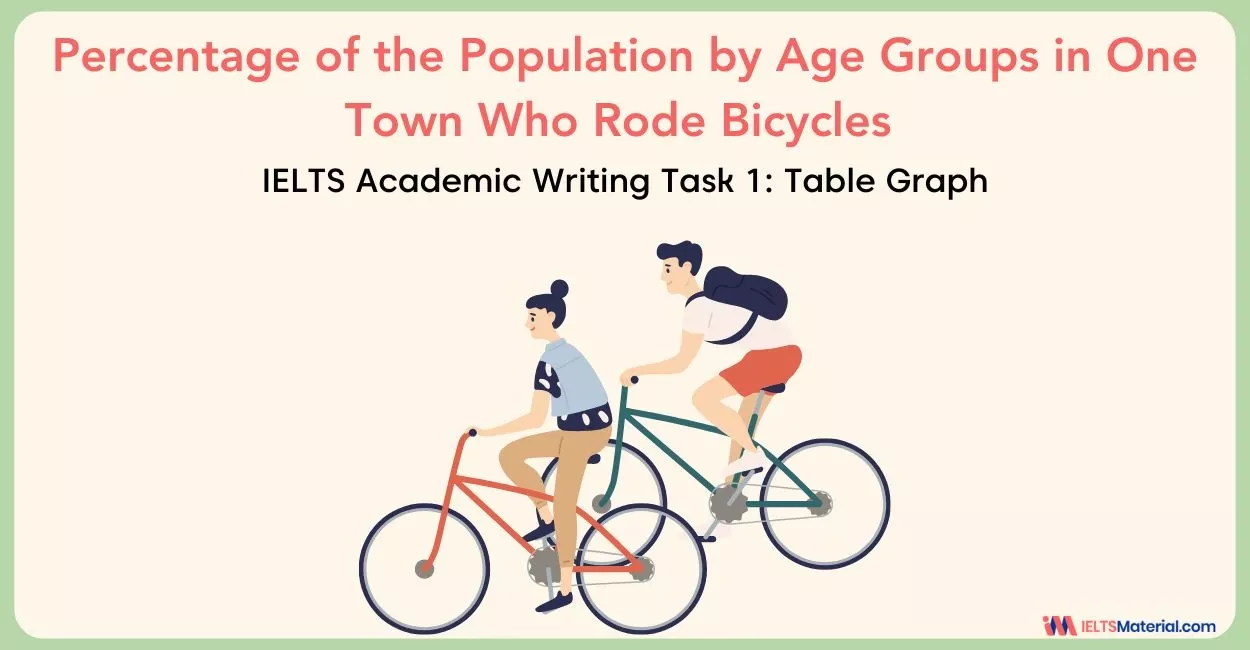The table below shows the percentage of the population by age groups - IELTS Writing Task 1
Master IELTS table graph topics like ‘The table below shows the percentage of the population by age groups’ to approach them confidently on the IELTS exam. Examine the outline, example responses, and learn to describe data to improve your writing score.
Table of Contents
- Question for The table below shows the percentage of the population by age groups - IELTS Academic Writing Task 1
- Outline for IELTS Writing Task 1 Table Chart
- Sample Answers on ‘The table below shows the percentage of the population by age groups'
- Tips for IELTS Writing Task 1 Table Graph - The table below shows the percentage of the population by age groups

Try AI Essay Checker for Instant Band Score
In IELTS Writing Task 1, candidates are often presented with visuals like table graphs. They require you to compare numerical data, identify trends, and highlight significant differences, just like in the topic, ‘The table shows the percentage of the population by age groups in one town who rode bicycles in 2011’. Your task is to describe the data clearly and objectively, without inserting personal opinions.
In this blog, we will examine how to approach an IELTS Academic Writing Task 1 question based on a table graph, 3 sample answers on ‘The table below shows the percentage of the population by age groups’, and tips related to IELTS table chart writing sample answers.
Question for The table below shows the percentage of the population by age groups - IELTS Academic Writing Task 1
The table below shows the percentage of the population by age groups in one town who rode bicycles in 2011.
Summarise the information by selecting and reporting the main features, and make comparisons where relevant.
Write at least 150 words.
| Age Group | Female | Male |
|---|---|---|
| 0-9 | 51.3 | 50.3 |
| 10-17 | 42.2 | 24.6 |
| 18-39 | 17.1 | 9.7 |
| 40-59 | 12.3 | 8.0 |
| 60+ | 18.5 | 13.2 |
Outline for IELTS Writing Task 1 Table Chart
Given below is a detailed structure that will assist you in organizing your answer for IELTS table charts.
|
Introduction
Overview
Body Paragraph 1
Body Paragraph 2
Conclusion (Optional)
|
Need expert advice on tackling IELTS line charts?
Book a free trial & talk to our experts NOW!
Sample Answers on ‘The table below shows the percentage of the population by age groups'
Now, let us have a look at the sample answers for 'The table below shows the percentage of the population by age groups' below for different IELTS band scores, which will give you an idea of how to frame your answers with clarity.
The table below shows the percentage of the population by age groups - Sample Answer 1
The table depicts the proportion of people from all age groups in a town who rode a bicycle in the year 2011.
We understand from the table that the percentage of female cyclists was much higher than male cyclists in all age groups. Meanwhile, for both genders, the proportion of the population who rode bicycles was the lowest between the ages of 18 and 59, respectively.
Among the age group between 0 and 9, the proportion of female cyclists was 51.3%, while it was 50.3% for the male cyclists of the same group. At the same time, the proportion remained high among 10-17-year-old females at about 42%, and the percentage of males gradually declined by over half to less than 25% in the same age group.
The percentages for both genders aged 18-39 were significantly lower at just 17.1% and 9.7%, respectively. Besides, the figures slowly dropped for females and males aged between 40-59, which were merely 12.3% and 8%.
Moving to the oldest age group, which is over 60+, the percentage of cyclists from both genders increased, which accounted for 18.5% for females and 13.2% for male cyclists.
Join FREE online webinars to learn how to deal with IELTS line graphs for IELTS success!
The table below shows the percentage of the population by age groups - Sample Answer 2
The table illustrates the percentages of people in different age groups who rode bicycles in a town in 2011, divided into males and females. Overall, it can be seen that a higher proportion of females cycled than males in every age group. Cycling was most common among children, while participation dropped significantly among middle-aged adults before rising slightly in the elderly category.
In terms of children aged 0–9, the majority of both genders rode bicycles, with figures at 51.3% for girls and 50.3% for boys, making them the most active group overall. The teenage group (10–17) also recorded relatively high rates, but with a notable gender gap, as 42.2% of females cycled compared to only 24.6% of males.
By contrast, the proportions were much lower among adults. Only 17.1% of females and 9.7% of males aged 18–39 used bicycles, while the figures for the 40–59 group fell even further to 12.3% and 8.0% respectively, the lowest rates recorded. Interestingly, the 60+ group showed a small increase, with 18.5% of females and 13.2% of males still cycling.
In summary, cycling was most widespread among children, less popular among working-age adults, and women consistently showed higher participation rates than men.
Access the latest IELTS Writing Task 1 line graphs with our IELTS Writing Task 1 Academic Course!
The table below shows the percentage of the population by age groups - Sample Answer 3
The table provides data on the percentage of people in one town who cycled in 2011, categorized by gender and five different age groups. Overall, it is clear that cycling was most prevalent among children, especially girls, whereas the lowest figures were found among middle-aged adults. Another noticeable feature is that in every age group, females outnumbered their male counterparts in terms of bicycle use.
Looking more closely at the figures, over half of both boys and girls aged 0–9 rode bicycles, with girls (51.3%) slightly ahead of boys (50.3%). Among teenagers (10–17), female participation remained relatively high at 42.2%, whereas the percentage of males dropped sharply to just 24.6%, showing the widest gender disparity in the table.
In adulthood, cycling rates declined dramatically. Only 17.1% of women and fewer than one in ten men (9.7%) aged 18–39 cycled, while the figures fell further to 12.3% and 8.0% respectively for the 40–59 age group. Interestingly, the trend reversed somewhat among the elderly, as 18.5% of women and 13.2% of men aged 60 and above continued to cycle, surpassing the middle-aged categories.
Get expert feedback for your answers with get improvement tips
All you need to do is submit your IELTS writing answer for evaluation!
Tips for IELTS Writing Task 1 Table Graph - The table below shows the percentage of the population by age groups
To achieve a Band 9 score on the ‘The table below shows the percentage of the population by age groups’ table graph, you must go beyond simply describing figures. Let us check out some IELTS exam preparation tips for band score of 8+ in similar IELTS table graphs.
- Always paraphrase the question: Repeating the task prompt word-for-word lowers your lexical resource score. Instead, show flexibility by using synonyms and rephrasing sentence structure. This demonstrates vocabulary range and grammatical variety right from the start.
- Write an overview: The overview is the most important part of Task 1. It should summarize the main trends or significant patterns without numbers. Many candidates miss this, but examiners expect it. So, always dedicate 2–3 sentences to the overview, either with the intro or in a separate paragraph, before moving into details.
- Group information logically: Do not describe the table row by row, which makes your answer look like a list. Instead, organize data into meaningful groups. You could group by:
- Age categories (children vs. adults vs. elderly)
- Gender comparisons (male vs. female in each group)
- Compare instead of listing: The IELTS band descriptors emphasize comparisons. Tables are designed for comparing rows and columns. Always highlight differences and similarities.
- Use a range of vocabulary: Tables require varied descriptive and comparative language. Vocabulary variety strengthens your lexical resource score.
- Avoid personal opinions: IELTS Writing Task 1 is a factual report, not an essay. Never add explanations, reasons, or personal comments. Stay objective and stick to what the table shows.
- Maintain accuracy in figures: You do not need to write every number, but the ones you include must be accurate. Use approximation for clarity and variety. This avoids repetition of exact percentages and demonstrates precise academic writing skills.
- Practice variety in sentence structures: Examiners look for a mix of simple, compound, and complex sentences. Use IELTS Writing Task 1 connectors and comparative clauses to achieve fluency. Grammatical variety can be the difference between Band 6.5 and Band 7.5+.
To conclude, describing IELTS Writing Task 1 tables, like ‘The table below shows the percentage of the population by age groups’ requires analysis, grouping, and comparisons. If you paraphrase effectively, write a clear overview, and use accurate comparisons with varied vocabulary, you will be able to produce a high-scoring response. Do not forget to practice with similar recent IELTS Writing Task 1 topics academic with model answers to expand your range.
Useful Links:
- IELTS Writing Task 1 Table : Information About Underground Railway Systems in Six Cities
- IELTS Writing Task 1 Table - Changes in Modes of Travel in England
- Past And Projected Population Figures In Various Countries - IELTS Writing Task 1
- Most Common IELTS Graph Synonyms to Use
- Visuals: Writing About Graphs, Tables and Diagrams for IELTS Writing Task 1 (Ebook)
- All Useful IELTS Writing Lessons for 2025 | Task 1 & 2 Tips, Samples
Explore IELTS Writing

Start Preparing for IELTS: Get Your 10-Day Study Plan Today!
Explore other sample Tables

Nehasri Ravishenbagam

Kasturika Samanta

Recent Articles
Haniya Yashfeen

Kasturika Samanta







Post your Comments